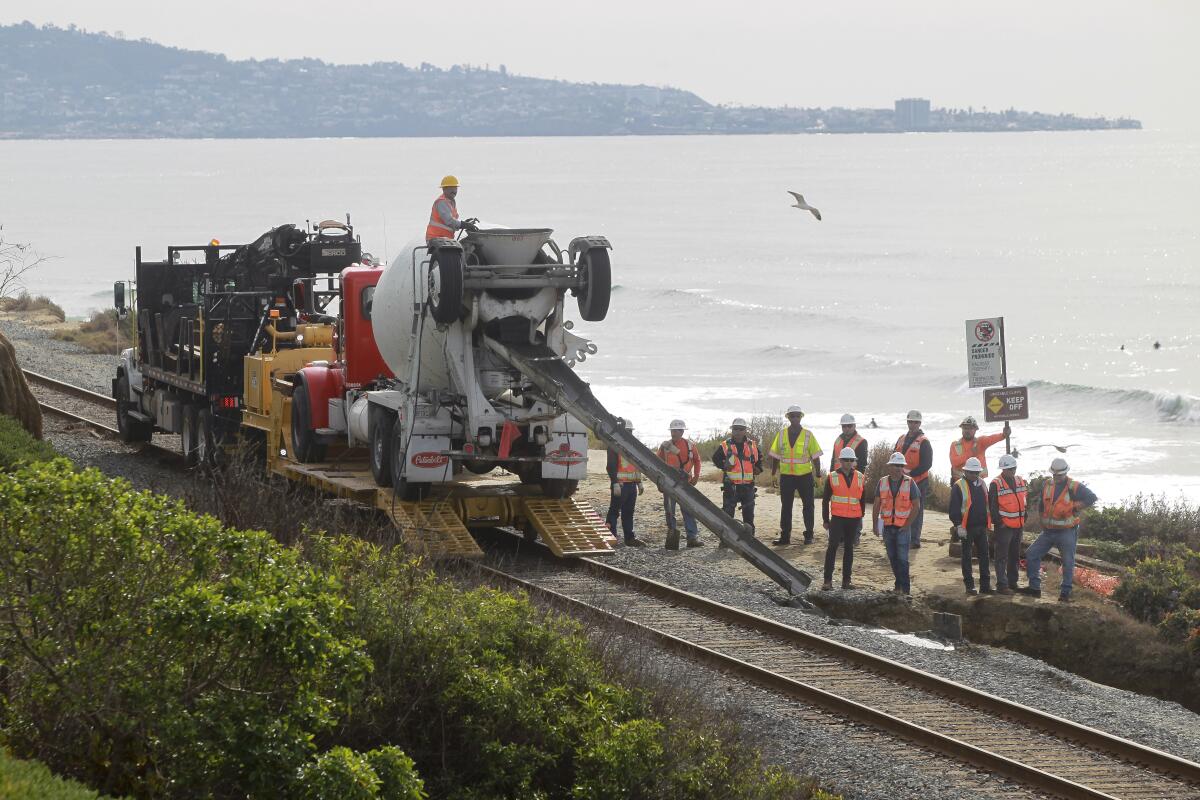Over objections, Coastal Commission approves Del Mar bluff stabilization projects

The work in Del Mar will include seawalls and beach access projects and is expected to take three years and cost $68 million.
- Share via
San Diego — The California Coastal Commission unanimously approved a three-year, $68-million series of projects Wednesday to stabilize the train tracks on the eroding Del Mar bluffs, despite objections to some of the work from residents and the North County Transit District.
The transit district, which maintains and operates the tracks, opposed three beach access projects recently added to the bluff stabilization effort, which is overseen by the San Diego Assn. of Governments, the regional planning agency.
For the record:
9:39 a.m. June 9, 2022An earlier version of this story misspelled the name of Paloma Aguirre, a council member for the city of Imperial.
Plans for a mile-long bluff-top trail, a pedestrian rail crossing and a ramp or stairs to the beach were added at the Coastal Commission’s request to compensate for the loss of public beach caused by seawall construction.
“These conditions impose significant obligations and costs well beyond the safety project,” NCTD Executive Director Matt Tucker told the commission Wednesday during its meeting at the Hilton San Diego/Del Mar.
“Please keep in mind that the vast majority of NCTD customers are bus riders,” Tucker said. “The conditions being proposed by the Coastal Commission would result in a direct take-away of investments ... from low-income and minorities customers, students, and working families to benefit one of the most affluent cities in San Diego County.”
Residents of Del Mar say that their beaches get millions of visitors annually from across the state and that they should get two pedestrian crossings instead of just one. It’s the county’s smallest city, located entirely between the ocean and Interstate 5, with a population of a little more than 4,000 people.
Del Mar City Council member Terry Gaasterland read a letter approved by the council stating that the city has “serious concerns about the adverse effects of seawalls” that are one of the three major elements of the bluff stabilization plan.
The San Diego Assn. of Governments has said its plan is a “three-legged stool” with seawalls at the base of the bluffs, concrete-and-steel soldier piles dug into the top, and a system of concrete drains along the tracks and atop the bluffs to divert storm water from the face of the cliffs.
Del Mar approves of the soldier piles and drainage ditches, but not the more than 2,000 linear feet of additional seawalls to be installed, Gaasterland said. She suggested the walls be installed in sections as needed because the bluff “erodes periodically and episodically.”
Coastal Commission Executive Director Jack Ainsworth responded that the San Diego Assn. of Governments’ proposal, including the mitigation projects, took a lot of hard work between the agencies involved and will resolve longstanding issues and safety concerns.
“The engineering elements all act in concert,” Ainsworth said. “You can’t just pull one out. Waiting to install seawalls at another time would simply be dangerous and irresponsible ... like playing Russian roulette with the safety of trains traveling on there and people’s lives.”
The bluff stabilization is intended to be a temporary solution until the 1.7 miles of track in Del Mar can be moved inland, he said. “Hopefully, that line can be removed by 2035,” he said.
The version of the project presented Wednesday is “an incredible vast improvement” over previous proposals, he said, and that “the whole program leads to a great outcome, in my view.”
He called the Del Mar work “the tip of the iceberg” of construction needed to protect the huge coast of California from sea-level rise, adding that “the whole point is to move critical infrastructure inland.”
Several commissioners said that, though they generally oppose seawalls, the agencies have worked together to find a solution.
“It’s been a difficult journey, but we’ve arrived at a good compromise,” said Commissioner Paloma Aguirre of the city of Imperial.
Climate change is coming more quickly than most people expected, she said, and coastal cities need to prepare.
“I cannot fathom thinking about a train full of people falling into the ocean,” Aguirre said.
Commission Chair Donne Brownsey praised the San Diego Assn. of Governments for its collaboration on the project.
“This is a managed retreat adaptation project,” Brownsey said. “As we know, the city of Del Mar has been reluctant to engage in these conversations and that planning.”
Just two years ago the association’s deadline was 2050 for moving the railroad off the bluff, she said. Now it’s 2035, after two recent Del Mar cliff collapses, and it could change again.
“We are required by law, the state and the public, to do what is prudent to help communities face this existential threat of sea level rise,” Brownsey said. “I know this is a tough project for some folks, but I think it is a prudent project ... I hope there are no accidents because we waited too long.”
The railroad tracks south of Powerhouse and Seagrove parks in Del Mar travel along the edge of 50- to 70-foot-tall bluffs with a history of landslides and slope failures.
The San Diego Assn. of Governments and North County Transit District began a series of phased stabilization projects in 1996 that consist primarily of installing soldier piles, drainage ditches, seawalls and retaining walls.
The phase approved Wednesday, the fifth, is expected to begin in late 2023 and be completed in 2026.
More to Read
Sign up for Essential California
The most important California stories and recommendations in your inbox every morning.
You may occasionally receive promotional content from the Los Angeles Times.














